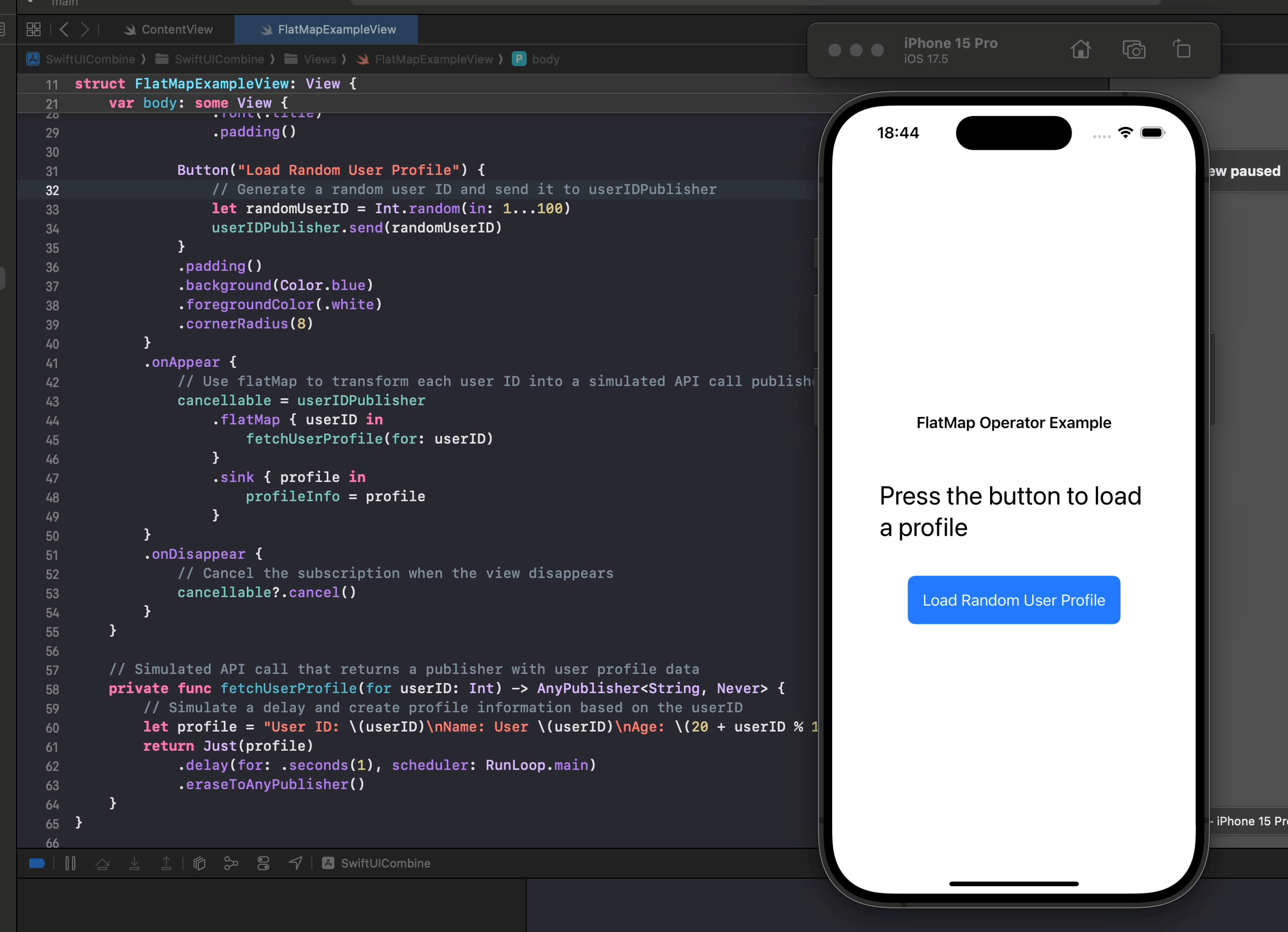In Combine, the flatMap operator enables you to take each value emitted by a publisher and transform it into a new publisher. This is particularly useful when working with asynchronous data flows, where you might want to perform additional tasks (like making network requests) in response to each value received.
What is flatMap?
The flatMap operator transforms each value emitted by a publisher into a new publisher. Unlike map, which only changes the data type, flatMap enables you to create new, independent publishers for each incoming value, and then merge their results back into a single data stream. This is useful when you need to handle complex data flows, such as performing a new API call based on each incoming value or chaining multiple dependent requests.
For example, you might use flatMap to:
- Trigger multiple asynchronous tasks based on incoming values.
- Merge the results of these tasks into one output stream.
- Dynamically generate and subscribe to new publishers based on each emitted value.
In this article, we’ll create a SwiftUI view that uses flatMap to simulate an API request for a user profile whenever a random user ID is generated.
Example SwiftUI View with flatMap
Below is a SwiftUI view that uses flatMap to simulate an asynchronous API request for user profile data based on a generated user ID. Each time a new ID is generated, flatMap creates a new publisher to fetch the user profile.
import SwiftUI
import Combine
struct FlatMapExampleView: View {
// State variable to display user profile information
@State private var profileInfo: String = "Press the button to load a profile"
// PassthroughSubject to publish random user IDs
private let userIDPublisher = PassthroughSubject<Int, Never>()
// AnyCancellable to store the subscription
@State private var cancellable: AnyCancellable?
var body: some View {
VStack(spacing: 20) {
Text("FlatMap Operator Example")
.font(.headline)
.padding()
Text(profileInfo) // Display the fetched profile information
.font(.title)
.padding()
Button("Load Random User Profile") {
// Generate a random user ID and send it to userIDPublisher
let randomUserID = Int.random(in: 1...100)
userIDPublisher.send(randomUserID)
}
.padding()
.background(Color.blue)
.foregroundColor(.white)
.cornerRadius(8)
}
.onAppear {
// Use flatMap to transform each user ID into a simulated API call publisher
cancellable = userIDPublisher
.flatMap { userID in
fetchUserProfile(for: userID)
}
.sink { profile in
profileInfo = profile
}
}
.onDisappear {
// Cancel the subscription when the view disappears
cancellable?.cancel()
}
}
// Simulated API call that returns a publisher with user profile data
private func fetchUserProfile(for userID: Int) -> AnyPublisher<String, Never> {
// Simulate a delay and create profile information based on the userID
let profile = "User ID: \(userID)\nName: User \(userID)\nAge: \(20 + userID % 10)"
return Just(profile)
.delay(for: .seconds(1), scheduler: RunLoop.main)
.eraseToAnyPublisher()
}
}
struct FlatMapExampleView_Previews: PreviewProvider {
static var previews: some View {
FlatMapExampleView()
}
}
Explanation of the Code
- State Variable:
@State private var profileInfo: Holds the user profile information displayed in the view. It starts with a placeholder message and updates whenever a new user profile is fetched.
- PassthroughSubject:
private let userIDPublisher = PassthroughSubject<Int, Never>(): This publisher emits random user IDs when the button is pressed.
- Button to Trigger a New User ID:
- The Load Random User Profile button generates a random user ID between 1 and 100 and sends it to
userIDPublisher. This triggers theflatMapoperator, which transforms the user ID into a new publisher that simulates an API call.
- The Load Random User Profile button generates a random user ID between 1 and 100 and sends it to
- The
flatMapOperator:- Inside
.onAppear, we useflatMapto convert each user ID emitted byuserIDPublisherinto a new publisher created by thefetchUserProfile(for:)function.flatMapsubscribes to each new publisher and emits its results to the downstream subscriber. - Each time a new user ID is generated,
flatMapensures that a fresh user profile is fetched based on that ID, with the results merged back into a single stream.
- Inside
- Simulated API Call with
fetchUserProfile(for:):- The
fetchUserProfile(for:)function simulates an asynchronous API request, returning aJustpublisher that emits a user profile string after a 1-second delay. This delay simulates network latency and gives the impression of an actual network request. - The returned publisher is then transformed with
.eraseToAnyPublisher()to make it compatible withflatMap.
- The
- Cleaning Up the Subscription:
- The
.onDisappearmodifier cancels the subscription when the view disappears, preventing memory leaks or unintended updates when the view is no longer on screen.
- The
How flatMap Helps in SwiftUI
In this example, flatMap allows us to dynamically create new publishers for each user ID and merge their results. Each time a new user ID is generated, flatMap creates a unique publisher for fetching that user’s profile and merges it into a single stream. This makes flatMap ideal for managing asynchronous tasks triggered by changing input data.
Summary
The flatMap operator is one of Combine’s most powerful tools, enabling you to create dynamic, nested publishers based on incoming data. It’s especially useful in SwiftUI for managing complex data flows, such as network requests or other asynchronous tasks, where each emitted value might lead to a new task. With flatMap, you can create, manage, and merge multiple publishers seamlessly, making it easier to build responsive and data-driven SwiftUI apps.
